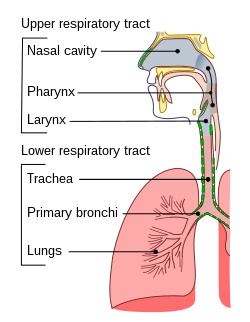Lower respiratory tract
| Respiratory tract | |
|---|---|

Conducting passages
|
|
| Details | |
| System | respiratory system |
| Identifiers | |
| FMA | 265130 |
|
Anatomical terminology
[]
|
|
In humans, the respiratory tract is the part of the anatomy involved with the process of respiration.
The respiratory tract is divided into the upper airways and lower airways. The upper airways or upper respiratory tract includes the nose and nasal passages, paranasal sinuses, the pharynx, and the portion of the larynx above the vocal folds (cords). The lower airways or lower respiratory tract includes the portion of the larynx below the vocal folds, trachea, bronchi and bronchioles. The lungs can be included in the lower respiratory tract or as separate entity and include the respiratory bronchioles, alveolar ducts, alveolar sacs, and alveoli.
The respiratory tract can also be divided into a conducting zone and a respiratory zone, based on the distinction of transporting gases versus exchanging them.
From the bronchi, the dividing tubes become progressively smaller with an estimated 20 to 23 divisions before ending at an alveolus.
The upper respiratory tract, can refer to the parts of the respiratory system lying above the sternal angle (outside of the thorax), above the vocal folds, or above the cricoid cartilage. The larynx is sometimes included in both the upper and lower airways. The larynx is also called the voice box and has the associated cartilage that produces sound. The tract consists of the nasal cavity and paranasal sinuses, the pharynx (nasopharynx, oropharynx and laryngopharynx) and sometimes includes the larynx.
...
Wikipedia
